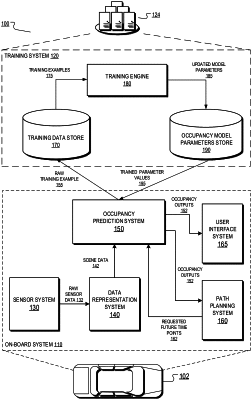| CPC H04W 4/027 (2013.01) [G06F 18/214 (2023.01); G06F 18/2321 (2023.01); G06N 3/044 (2023.01); G06N 3/045 (2023.01); G06N 3/047 (2023.01); G06N 3/049 (2013.01); G06N 3/08 (2013.01); G06N 20/00 (2019.01); G06V 10/764 (2022.01); G06V 10/82 (2022.01); G06V 20/56 (2022.01); H04W 4/029 (2018.02)] | 19 Claims |

|
1. A method comprising:
obtaining scene data characterizing an environment at a current time point;
receiving a request from a planning system of an autonomous vehicle for a respective occupancy prediction at each of multiple future time points that are each after the current time point, wherein each future time point corresponds to a different time interval into the future relative to the current time point;
processing a first network input generated from the scene data using a first neural network to generate an embedding of the environment at the current time point;
processing a plurality of different inputs using a second neural network,
wherein each of the plurality of different inputs includes (i) the embedding of the environment at the current time point and (ii) a different one of the time intervals into the future relative to the current time point, and
wherein for each of the plurality of different inputs, the second neural network is configured to generate an occupancy output for the future time interval in the input that comprises respective occupancy probabilities for each of a plurality of locations in the environment, wherein the respective occupancy probability for each location characterizes a likelihood that one or more agents will occupy the location after the future time interval; and
providing, to the planning system, the respective occupancy outputs for the multiple future time points.
|